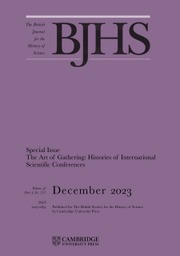Edward J. Gillin’s latest book is an original and deeply researched retelling of the history of geomagnetism and the so-called magnetic crusades: the British effort in the 1840s and 1850s to map the Earth’s magnetic field. What Gillen more rightly calls the British Magnetic Scheme (BMS) depended for its success upon an unprecedented system of coordinated labor, with dozens of disparate stations performing measurements on exactly the same day at exactly the same time, using exactly the same methods. Gillin finds a refreshing new perspective on the subject by bringing one delicate and essential part of the sociotechnical system – the Fox-type dip circle and its makers and users – to the centre of the story. This particular dip circle, which would become widely used in British geomagnetic expeditions, was invented in 1832 by the Cornish natural philosopher Robert Were Fox.
Dip circles had long been used by natural philosophers to observe not the direction of magnetic north (as in a common compass) but the angle of magnetic dip; that is, the angle of the Earth’s magnetic field relative to the horizon, measured by the up-or-down movement of a magnetized needle. By the early nineteenth century, both practical issues (mining and navigation, particularly in new iron-hulled ships) and theoretical issues (electrical physics and the emerging geological sciences) generated widespread interest in attempting to map the complex patterns of variation in magnetic dip across the globe. Born into Falmouth’s leading shipbroking family, Fox was among the first to devise a dip circle that was reliable and robust enough to be used on expeditions and aboard ships.
The book largely follows Fox’s career. The first three chapters give a fascinating view of the sciences of the mine in Cornwall, showing how particular mining problems influenced Fox’s natural-philosophical interests and led him to the innovative design of his dip circle. The third chapter the turns to the first trials and experiments of Fox’s new dip circle, and covers Fox’s successful entry into London’s scientific milieu, which would be critical for Fox’s own reputation as well as that of his instrument. The next three chapters follow the dip circle on expeditions to the poles, Africa and Asia. These chapters show in fascinating detail the amount of labor that went into constructing, testing, rating and maintaining these instruments. Fox was dependent on the Cornish instrument maker Thomas Brown Jordan (and later on William George). Although the financial side of the story remains unclear (how much was Jordan making from this work? Was Fox profiting from the instrument sales as well?) Gillin relays in detail the complexity of inventor–maker relations; Fox’s near-crippling dependence on Jordan is revealed when the latter moves from Cornwall to London for a position at the Museum of Economic Geology.
The formative influence of Fox’s family life and social ties on his scientific career come out strongly throughout the book. The Fox family connections to both mining interests and shipping were essential to the making of Fox’s career. Fox’s children Caroline, Barclay and Anna Maria seem to have been a near-constant presence in Fox’s scientific schemes. Anna Maria and Caroline in particular played an important role in the Royal Cornwall Polytechnic Society (chartered 1835), which in turn would become a critical means of communication with metropolitan scientific culture across Britain. Explorers and natural philosophers would be lured to the Fox estate in Falmouth in order to have their instruments examined and tested by Fox and his family, both before and after expeditions, and often in the context of a dinner party. The Fox family were also Quakers, and Fox made important scientific contacts among the Quaker community in both Cornwall and London. Thus, although the correspondence between Fox and Edward Sabine, director of the BMS out of Woolwich Arsenal, is a backbone of Gillen’s story, he has also brought into the frame a much wider group of actors than have typically appeared in histories of geomagnetism
The result is a compelling cultural history of one of the most ambitious state-funded scientific enterprises of its time. Although ‘empire’ is emphasized in the title, to this reader the real strength of the book is to show the deep, contingent local context (in this case Falmouth, and one particularly prominent family) of even the most ‘imperial’ scientific enterprises.
The instrument itself is examined and presented in such minute detail that it becomes like a well-sketched character: unpredictable and capricious but tolerated and admired nonetheless. It was ridiculously sensitive to environmental circumstances (if armed guards approached an observing party, their weapons could disturb the operations of the needle.) Remarkably, Gillin and the historian Crosbie Smith traveled with a Fox-type dip circle around the coast of Africa, re-creating the observation routines of the surveys, and the author’s tacit physical acquaintance with the instrument shines through, grounding the work in a material-culture sensibility.
As with other books in this style of micro-global history, Gillin’s ambitious attempt at a broad cultural history told via a close study of one instrument is challenging, and it is a tough balancing act at times. For example, although Gillin’s account of the interplay between Cornish mining and geomagnetic study is essential to his later story, it also felt unnecessary (to this reader) to also delve into the details of competing steam engine designs and Cornish steam engine culture as part of that contextualization.
But these issues do not decrease the immense value of this work. Gillin has produced an impressive and eye-opening sociocultural study of a critical period in the history of science in Britain.



